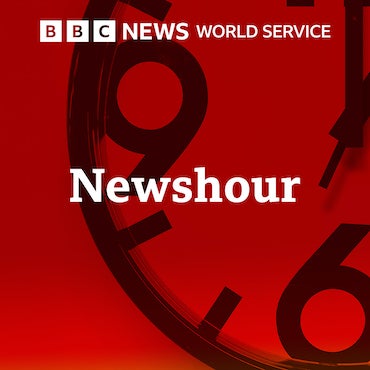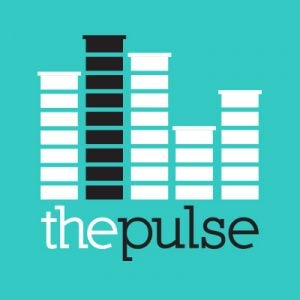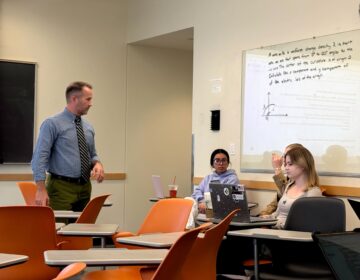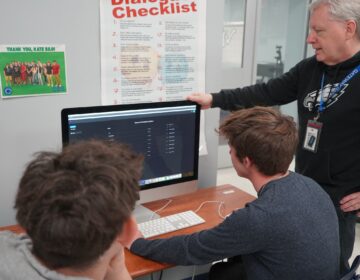Ban it or use it? How teachers are grappling with generative AI in the classroom
Generative AI tools have transformed classrooms. But local teachers and school districts are still deciding on whether, and how, to use them.
Listen 12:29
Kate Conroy, an English and journalism teacher at William L. Sayre High School in Philadelphia, has banned generative AI in her classes. (Kimberly Paynter/WHYY)
This story is from The Pulse, a weekly health and science podcast. Subscribe on Apple Podcasts, Spotify, or wherever you get your podcasts.
Find our full episode on education here.
Kate Conroy is very clear with her students that she is not okay with them using any generative AI in her class.
“I tell them that I come to this school and I come to work with kids because I find teenagers’ ideas interesting,” said Conroy, who teaches English, journalism, and creative writing at Sayre High School in West Philadelphia. “And if you hand me an essay written by ChatGPT, I’m bored and I didn’t come here to be bored, I came here to engage with you.”
She said that applies to her own work as well: she refuses to use generative AI for lesson planning, and hand crafts each question and assignment. She said her students get it.
“When kids realize that what you’re giving them is inauthentic, they’re going to give inauthenticity back. They’re going to give ChatGPT back. And when they realize that what I’m giving them is my authentic question, because I want to know their authentic answer, they don’t go to ChatGPT because they understand we’re in a human-to-human intellectual conversation, and it matters to me what they think because I really want to know.”
She recalled a student who told her about using generative AI to work on part of an essay, and came to Conroy about another writing assignment. Conroy worked with her based on a list of bullet points, and they came up with it together.
“And when we finished, I said, ‘wasn’t that fun? We just solved a puzzle.’ And she said, ‘yeah, it was really fun to do that.’ And I know that that’s not fun for every kid to write an essay. But I’ve read and heard a lot about using AI as … a thought partner … And I just think: who could really say that it’s better to talk to a computer about your essay than to talk to the person next to you?”
Conroy knows other teachers feel differently about generative AI, but said that “to use generative AI as a student is to not believe in your own brain. And to encourage kids to use AI to me is to tell them that I don’t believe in their brain … that they cannot come up with something good on their own.”

Generative AI tools like ChatGPT, Google Gemini, and Claude have transformed classrooms since they became popular around two years ago. Some teachers use tools to detect whether their students use generative AI for their homework, some report that they want students to only do work in school using pencil and paper, and others use generative AI themselves to grade student work and analyze student data.
School districts are still grappling with how to handle generative AI. The School District of Philadelphia blocked ChatGPT from school devices in 2023 to learn more about the technology, and have since come up with a generative AI policy and approved the use of Google Gemini for some work.
Subscribe to The Pulse
Gateway Regional School District of New Jersey also developed a generative AI policy, after staff realized it can help students in the classroom, explained Amy Mount, director of curriculum and instruction. For instance, she said one of their approved generative AI tools can change a reading assignment into different languages or a different reading level, freeing up a teacher for more one-on-one time with students.
“The hardest thing for a teacher is having the bandwidth to personalize for every kid in the classroom,” Mount said.
French teacher Kim Karwoski sometimes has her students practice speaking French with one of the district’s approved AI chatbots, because some students feel less pressure when talking to a bot, versus another person.
She said the chatbot does not replace her as a teacher, but makes her think more deeply about what students should be learning.
“AI is … going to push us to make these big changes in education that I think … have been coming to a boil anyway.”
For example, she said that in the past, she might have assigned students to write a paragraph in French about what they did over the weekend, to practice different forms of the past tense. But now, if students want to, they could just use generative AI to create a paragraph like that. So now, she may ask her students to practice on paper and pencil, or with a bot, or with another student, and then have a live conversation using all that they learned.
“That’s a more authentic task because … you’re now having the students speak and practice something that they might actually do if they were to go to France or a French-speaking country.”
However, there are still many other teachers who, like Conroy, refuse to use generative AI in their classes. That worries Lakishia Powell, instructional technology coach for Delsea Regional School District in New Jersey.
“If you think about any kids that are born now, they’re not going to know a world without AI. So why wouldn’t we as educators want to prepare them with a good skill set, a nice base or understanding of it and showing them the right way to use it?”
She said generative AI is like Wikipedia and calculators: students can still learn while using these tools, and there will always be people who disagree.
In fact, students almost have to use AI in the modern job market, said Kathleen Bially, media specialist at Gateway Regional High School. She pointed out that many large companies use AI to screen candidates, so “you sort of have to play the game in a way by allowing a computer to help another computer to see you. And if we’re not doing that, we’re going to be left out.”
WHYY is your source for fact-based, in-depth journalism and information. As a nonprofit organization, we rely on financial support from readers like you. Please give today.







